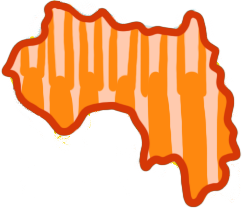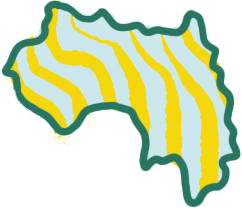Text
In this chapter, I'm going to introduce you to presentative sentences, so that you can present or identify things (e.g., "It's a boy", "This is my house", etc.) and began to talk about the people and things around you.
Specifically, we will cover the presentative copula* and its negative counterpart:
le/nefor affirmative sentences (e.g., "It's a girl")tɛfor negative sentences (e.g., "It/this/that is not my bike")
(*NOTE: "Copula" is a fancy word that linguists use to describe words that are verb-like, but technically aren't quite verbs. No need to focus on the term itself for the purposes of speaking Manding though, so don't worry!)
► Where there is no "to be"
First, let's take a step back so you can understand why there's a specific chapter on "presentatives", something that you may have never heard of.
Maninka is not a language with a verb equivalent to "to be". This doesn't mean that one cannot express the idea behind "to be", but it means that the language does it in ways that do not line up well with many Western languages.
In English, we use the verb "to be" to express a lot of things. Note how the following sentences all fundamentally do different work:
- It is me. –> PRESENT/IDENTIFY
- I am a teacher. –> EQUATE
- I am in Paris. –> LOCATE
- I am tall. –> DESCRIBE
In Maninka, and Manding in general, we use a different grammatical structure for each of these kinds of statements.
In this chapter, we will unpack "presenting" or "identifying".
Affirmative ("It's ...")
To present or identify something in Maninka, we use the presentative copula le, which we can translate for now as meaning "It's".
Let's start with an example to show you how le gets used:
Kitabu le
'It's a book.'
Here I have translated the sentence as "It's a book", but I could have just as easily translated it as 'It's the book'. For now, let's just say that which one is appropriate in translation depends on the context.
(NOTE: Actually in Manding, tone—the relative pitch of one's voice—plays a role in distinguishing definite ["the"] from indefinite ["a/an"].)
The structure that underlies this example and all other presentative sentences is as follows:
NOUN +
le
NOUN + it.is'It is (a/the) NOUN'
This word order is fixed: the noun always precedes le:
Le kitabu
'It's a book'
The word le can also superficially change and appear as ne based on the sound that precedes it.
This happens when the word preceding it ends in a nasalized vowel. For instance:
Bon le → Bon ne
"It's a house"
Or:
Sunkudun le → Sunkudun ne
It can also occur when the last consonant of the preceding word is a nasal one like ɲ, n or m. It's not always the case, but it often occurs when people speak quickly. For instance:
Tuɲa le!
OR
Tuɲa ne!
"It's true!" (Lit. "It's truth!")
As such, we can think of the presentative copula as actually being le/ne.
(NOTE: Watch out! If you see the written form ne, you will need to ask yourself if it is the presentative copula or the emphatic first person pronoun ne meaning 'I; me'. Later down the road, you will also learn about le/ne as a particle that is used for emphasizing specific words. But don't worry about that for now. Just now that you may run into other words that are also written le/ne.)
Besides the sound change linked to nasalization, le/ne itself will never change. There's no need to worry about "conjugation" to make the word match anything like gender, number, etc.
The noun, however, can vary. For instance, it can be:
-
a common noun
Muso le
'It's a woman'
-
a proper noun
Adama le
'It's Adama'
-
modified with an adjective
Mɔbili belebele le
'It's a large car'
-
plural
Mosolu le
"It's (some/the) women"
-
with a number:
Kɛ fila le
'It's two men'
-
etc.
(NOTE: In Maninka, the presentative copula is le/ne. In Bambara the presentative copula is don. In Jula, the presentative copula is written and pronounced lo. For an English speaker, all of this might look and sound quite different, but it's often just considered a question of so-called "accent", by speakers of Maninka, Bambara and Jula.)
Negative: "It's not ..."
The negative presentative copula is tɛ. It is used in exactly the same place and way as le/ne:
NOUN +
tɛ
"It's not + (a/the) NOUN"
With this in mind, we can easily make any of the above sentences negative. For instance:
Muso tɛ. Kɛ le!
"It's not a woman. It's a man!"
Or:
Kitabu tɛ. Kala le!
"It's not a book. It's a pen!"
Or, to take a new example:
Sɔɔma tɛ. Tele fɛ le!
"It's not (the) morning. It's the day time!"
► Multiple translation possibilities: It, this/that, he/she
We refer to le/ne and its negative equivalent tɛ as presentative copulas because they are primarily used in instances where one is, in some kind of way, presenting or identifying something.
In some cases, this means literally pointing at or gesturing towards something. In other cases, the act of presenting is implied by the context. Because of this, the best translation can sometimes vary in English.
It's ...
As suggested from the start, it often makes the most sense to use "It's ...". (Indeed, most students find this is the easiest solution to keep things straight early on.)
For instance, if you are walking down the street with a friend and you stop in your tracks to observe something you see flying across the sky, your friend might ask you:
– Mun ne?
– Kɔnɔ le.– What is it?
– It's a bird. [while pointing to the bird that you noticed]
Or, for example, imagine that you are resting at home and you hear someone knock at your door:
– Jɔn ne?
– Adama le!– Who is it?
– It's Adama!
(NOTE: You may have noticed that the word order of a presentative sentence with le/ne did not change when we used the question words mun ('what') and jɔn ('who'). It simply takes the place of the noun; no need to switch things around like in English. You'll learn more about question words down the road).)
This/that is ...
Other times, it lines up better with "This is ...". For instance, if you visited a friend and brought your spouse along for the first time, you might greet your friend and then, gesturing towards your wife, say:
N moso le.
'This is my wife'
But things could just as easily work with "That is ...". For instance, imagine you and your partner where flying to Guinea and looking out the window. As you approach the capital, one of you might point to the city in the distance and say:
Conkary le!
"That's Conakry!"
He/she is ...
Finally, in some cases, presentatives can translate as "He/she is ...".
For instance, let's imagine that you and a friend are listening to a radio show where an outlandish male politician is being interviewed. The politician says something ridiculous. At this point, your friend might say to you:
Fatɔ le
"He is a crazy person"
(lit. "It's a crazy person"; as in, 'This [guy that we are listening to] is a crazy person')
Notice that the sentence Fatɔ le only has two words in it: fatɔ and le/ne. This means that there is only one noun in the sentence. But in English, it is translated with using 'he' and 'crazy person', which is two nouns. This stems in part from the fact that in English we generally do not refer to people with the word "it".
This kind of usage often seems odd to many beginner students, but it's very frequent and totally normal in Maninka.
Usefulness & limitations
What's nice about this usage is that it allows you, as a new student of Maninka, to say the following:
-
Mun ne?('What is it?' or 'What is this?')You can use this expression to learn the name of anything that you can see and point out around you.
-
Jɔn ne?('Who is it?' or 'Who is this?')With this expression you can learn the name of any people that you can point out.
That said, one needs to be careful with this new power. The presentative can be used in the situations we have covered in this chapter, but it cannot be used everywhere that one would use "to be" in English.
For instance, in English we use "to be" with adjectives; we might see a car and say something like "It is black." This will not work in Maninka, or Manding in general, since "It is black" does not follow the structure of NOUN + le/ne/tɛ. "Black" is an adjective in this sentence.
Why can't we just say it like in English? Well because...
Maninkakan ne. Anglais-kan tɛ.
'It's Maninka, not English.'
(Literally, 'It's Maninka. It's not English.)
In the coming chapters on "Equatives", "Qualitative Verbs" and, we will learn three additional grammatical structures that in English are all covered by the verb "to be"
►"Just saying hi"
One final thing! With your new knowledge of presentatives, you now have the ability to tactfully take leave after saying hello to people.
You can do this with the word foli ('greeting').
When you want to explain why you stopped by to greet someone or you want to avoid having to sit down for a longer visit, you can use this word in the following expression:
Foli le!
"It's a greeting!"
(as in, "[I was/am] just saying hi!")
In response, your interlocutor will typically respond:
I ni ke foli la!
'Thanks for the greeting!'
(lit. 'Thanks on the greeting')
There's another presentative expression that fits into this kind of act too; it works with a special noun (derived from an adjective; you'll learn more about them down the road), juuman 'something bad', and the negative tɛ:
Juuman tɛ!
"It isn't something bad!"'
(as in, "I haven't come with any bad news!"')
Juuman tɛ often appears before a Foli le.
For instance, here's an example of how the expressions can fit into a very brief exchange:
– I ni ke!
– Nba! I ni ke!
– I ka kɛndɛ?
– N ka kɛndɛ! I jɛdɛ don?
– Hɛrɛ dɔrɔn. Juuman tɛ. Foli le!
– I ni ke foli la!
– An bɛn!– Hello!
– Nba! Hello!
– Are you healthy?
– I am healthy! And yourself?
– Peace only. No bad news. Just saying hi!
– Thanks for the greeting!
– Goodbye!
Summary
Ayiwa! Here's a simple take-away of what we covered:
- There is no verb "to be" in Maninka
- There are two presentative copulas that allow us to present or identify people and things:
le/ne: affirmativetɛ: negative
- It is used to say "It is" or "It is not" in combination with a noun:
Moso le: 'It's a woman'Moso tɛ: 'It's not a woman'
Le/neandtɛnever change regardless of the noun- The noun can take different forms:
Mosolu le: 'It's women'Mɔbili finman ne: 'It's a black car'Sara le: 'It's Sara'- etc.
- The exact translation of
le/tɛcan vary:Ne le= It's me [identifying yourself on the phone]N fa le= This is my father [presenting your dad to a friend]Conakry le= That's Conkary [pointing out the window of an airplane as approaching]Fatɔ le= He's a crazy person [talking about someone speaking on the radio]
- The presentative figures into a few leave-taking expressions:
Juuman tɛ!= It's nothing bad!Foli le!= It's a greeting (and its responseI ni ke foli la['Thanks for the greeting'])
Vocab
Coming soon n'Ala sɔnna!
- X le/ne.
- It/this/that is X.
- X tɛ.
- It/this/that isn't X.
- kala
- pen
- kitabu
- book
- kan
- language
- jamana
- country
- dɔnkili
- song
- jɔn
- who
- mun
- what
- Jɔn ne?
- Who is it/this?
- Mun ne?
- What is it/this?
- Foli le.
- "It's a greeting."
- I ni ke foli la.
- Thanks for the greeting.
- Juuman tɛ.
- "It's nothing bad."
- politikimɔɔ
- politician
- dɔnkililala
- singer
- feerela / feerekɛla
- seller; merchant
- dɔɔtɔrɔ
- doctor
- karamɔɔ
- teacher
- karanden
- student
- mɔɔ
- person
- den(nɛn)
- child
- tubabu
- White person; Westerner
- fadafin
- Black person; African
- n [family.member]
-
my [family.member]
- i/álu [family.member]
- your [family.member]
- à [family.member]
- his/her [family.member]
- àlu [family.member]
- their [family.member]
- somɔɔ
- family member [Bambara/Jula]
- denbaya
-
(nuclear) family
- n na denbaya
- my family
- fa(kɛ)
- father [and paternal uncles]
- na
- mother [Maninka]
- ba(moso)
- mother [Maninka/Bambara/Jula]
- bɛnɔɔnɛn
- paternal uncle (older than one's father)
- bɛnɔɔba
- paternal uncle (younger than one's father)
- kɔdɔ
- elder sibling
- dɔɔ
- younger sibling
- mɔkɛ/mamakɛ
- grandfather
- mɔmoso/mamamoso
- grandmother
- bidan
- in-law
- tɛnɛn(moso)
- paternal aunt
- barin(kɛ)
- maternal uncle
- bɛn/ben(kɛ)
- nephew
- bɛn/ben(moso)
- niece
- sunkudun
- young woman/girlfriend/lover
- kameren
- young man/boyfriend/lover
- balima
- kin; comrade
- ni
- and
- ani
- and (lit. 'it and')
- wala/walima
- or
- tuɲa
- truth
- wuya
- lie; fibbery
- N/ne bolo...
- "In my opinion..." (lit. 'My arm')
- I bolo...
- "In your opinion..."
Vocab list will be here someday!
Flashcards will be here someday!
Exercises
Exercises will be here someday!




